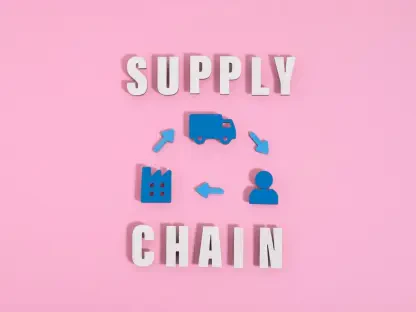William Ainslie sits down with Zainab Hussain, an e-commerce strategist known for bridging customer engagement with operations management. With Black Friday and Cyber Monday shaping up to be a record-breaker—VoucherCodes projects £9.52 billion in spend, up 4.2% year over year, and Nationwide expects 12 million transactions on day one—Zainab shares how to peak-proof supply chains without sacrificing experience. We explore how to get stock retail ready despite diversified suppliers, what a real control tower looks like in practice, how to shrink the “returns void,” and how to combat fraud—especially when 35% of 16–24-year-olds say they might lie to get a refund. Along the way, she describes the operational choreography behind mobile kiosks, data audits that actually catch blind spots before customers feel them, and the reverse logistics playbooks that move goods from “in limbo” to “sellable” at speed.
VoucherCodes projects £9.52 billion for BFCM, up 4.2% year over year, and Nationwide expects 12 million transactions on day one. How do you model that surge operationally, what bottlenecks typically emerge first, and can you share an example where preparation changed the outcome?
I model it as a capacity shock along three planes: throughput, latency, and variability. The first bottleneck isn’t always pick faces—it’s pre-retail work like packaging and labeling, because diversified SKUs arrive in inconsistent formats. We build surge calendars tied to hour-by-hour order curves, validate carrier injection windows, and stress-test any manual step that can’t elastically scale. One year, we mapped the expected 10% lift versus the prior Black Friday baseline to the earliest “gate”—label compliance—and pre-kitted label sets by supplier family. When the spike hit, that prep meant cartons didn’t queue at inbound, so dock doors kept moving while competitors were stacking pallets like cordwood.
You highlight being “retail ready.” When SKUs arrive in mixed formats from diversified suppliers, how do you standardize packaging and labeling at pace, what error rates do you track, and can you walk through a step-by-step flow that cut delays during a past peak?
We triage by variance, not by vendor alphabet. The flow starts with receiving scans that auto-assign each carton to a “format lane” based on packaging profile. Next, mobile kiosks print compliant labels and documentation on the spot, and inspectors verify brand and system compliance before the SKU is released to put-away. The error rates we watch are mislabel incidence, mismatched barcodes to item masters, and non-compliant packaging flags—each one ties directly to downstream delays. In a prior peak, we staged a five-step pass: intake scan, format lane sort, kiosk label print, visual QC, and immediate put-away ticket. That eliminated the stop-start rhythm at the workstations and turned pre-retail into a smooth river instead of a series of puddles.
You mention mobile kiosks to automate and digitize labeling. Where did you deploy them first, what throughput gains or rework reductions did you see, and how did you train teams to avoid label mismatches during crunch time?
We started at inbound buffer zones where cartons stacked up waiting for compliant labels. The kiosks moved to the work, not the other way around, so there was less cart shuttling and fewer handoffs. We didn’t obsess over vanity metrics; instead, we monitored rework tickets and mislabel flags falling as crews got faster. Training was hands-on: scenario cards for common edge cases, a “two-tap” rule on the kiosk to confirm SKU-to-label alignment, and daily huddles that replayed the previous shift’s misses. During crunch time, we paired labelers with a roving verifier whose sole job was to catch the first mismatch—stopping the error cascade before it fanned out.
When extra pre-retail work causes bottlenecks, how do you triage tasks, who makes the call to re-sequence work, and what metrics—cycle time, first-time-right, labor hours—help you decide in real time?
We operate a war-room cadence with a single owner for re-sequencing—usually the site ops lead empowered by the control tower. Triage looks at cycle time versus service promise, and whether first-time-right is sliding, which tells us quality is cracking under speed. If labor hours climb but output plateaus, we know we’re pushing work into a constraint rather than around it. The re-sequencing rule is simple: prioritize SKUs with short lead-time orders and high return risk, because every hour they sit raises the chance they boomerang back during the Golden Quarter.
On end-to-end visibility, how do you build a “control tower” view across sourcing, fulfillment, stores, and reverse logistics, what data fields are must-haves, and can you share a dashboard example that drove a key decision in hours, not days?
The control tower is a stitched canvas—purchase orders, ASN milestones, inbound dock status, pre-retail completion, pick progress, carrier handoff, store receipts, and returns disposition. Must-have fields include identifier parity (SKU, UPC, and internal ID), unit status codes, compliance flags, and timestamp integrity from source to sale to return. We overlay exception heatmaps so operators see where latency is spiking, not just average performance. One BFCM weekend, the dashboard lit up with rising exceptions in pre-retail labeling; within hours we pulled mobile kiosks and verifiers to that node and cleared the queue before it bled into pick waves.
You recommend auditing data accuracy ahead of peak. What’s your audit checklist, how do you test channel-to-channel communication, and can you describe a time when a manual process created a blind spot that you fixed before it hit customers?
The checklist starts with master data hygiene: SKU attributes, pack sizes, and barcode mappings. Then we test cross-channel messaging—orders flowing from web to OMS to WMS, and reverse messages like cancellations and returns acknowledgments. We run “canary” orders in every channel to verify full-loop confirmations and reconcile inventory deltas. Once, a manual spreadsheet was batching return receipts at end-of-day, creating a blind spot between noon and close. We replaced it with a real-time capture at the inspection bench, so the control tower saw returns the moment they were scanned, not hours later.
Connectivity gaps can skew demand signals. How do you instrument key nodes to ensure they create and report usable data, what latency thresholds do you enforce, and where have API limits or batch jobs tripped you up during BFCM?
We instrument nodes with event-driven hooks—scan events at receipt, completion events at pre-retail, and disposition events in returns. Every event must carry a consistent ID and timestamp so we can sequence truth. We hold ourselves to near-real-time flows; if a node drifts toward batch behavior during peak, the tower treats that as a risk alert. The biggest trips happen when partner APIs rate-limit just as the 12 million-transaction surge hits—so we stage critical updates, queue intelligently, and never let returns data ride on the same pipe as time-sensitive fulfillment events.
For warehouse and fulfillment optimization, which levers—slotting, wave planning, labor planning, carrier mix—drive the biggest wins during BFCM, how do you simulate scenarios, and can you share hard numbers on pick rates or dock-to-stock time improvements?
Slotting and wave planning do most of the heavy lifting when demand concentrates. We simulate with historical patterns overlaid with this year’s 4.2% uplift, then stress-test the top sellers’ paths to reduce footsteps and touches. Labor planning is the safety net—cross-trained crews and flex pools that swing between pre-retail and pick as the tower flags imbalances. I’m careful with numbers in public forums, but I can say that dock-to-stock improved visibly when we shifted labeling to the edge and released goods faster to live inventory, particularly on items that would otherwise linger in the “almost ready” state.
On reverse logistics, how do you define and shrink the “returns void,” what salvage rates do you set by category, and can you walk through a playbook that moved returned items back to live inventory within days instead of weeks?
The returns void is the dead air between “customer sends” and “item salable again.” We shrink it by pre-assigning inspection paths: fast-lane for pristine goods, function test for complex items, and refurb or secondary channels for anything borderline. Salvage rates are category-informed and codified so inspectors don’t debate edge cases under pressure. The playbook is simple: capture return reasons at intake, run fast-lane inspections with mobile guidance, print shelf-ready labels on the spot, and release back to inventory with no secondary queues. During BFCM, that cadence keeps items moving while shoppers are still in the mood to buy.
Impulse buying spikes returns. How do you segment returns by reason code, triage items for resale vs. refurb vs. secondary channels, and what timeline targets—intake to disposition—have actually stuck during peak?
We segment by signals that predict resale probability: wrong size or change of mind typically means high likelihood of immediate resale, while damage or missing parts routes to refurb or secondary. The triage lives in the device—inspectors pick a reason code and the system drives the next best step with clear criteria. Targets that stick are those aligned with capacity: fast-lane decisions at intake, refurb routed without overnight parking, and secondary channel prep gathered in timed batches. When shoppers are impulse-buying, speed matters twice: once to restock and once to avoid repeat returns born from delayed exchanges.
With 35% of 16–24-year-olds admitting they might lie to get a refund, how do you detect disingenuous returns like switched shoes or extreme wardrobing, what software signals matter most, and can you share a case where controls stopped fraud without slowing refunds?
We combine behavioral signals with physical inspections. Software flags include rapid serial returns, mismatched identifiers, and patterns like seasonal spikes in high-risk categories. On the floor, we train inspectors to spot “tells”—wear marks, odor, or packaging inconsistencies that photos won’t catch. One peak, switched footwear started popping up; the system flagged anomalies while inspectors confirmed with quick visual checks. Genuine returns were refunded promptly, but suspect items moved to a secondary review without clogging the main lanes, which kept honest customers happy and fraudsters frustrated.
You reference working with ReBound. How do you integrate fraud checks with quality inspections, what training or tooling keeps inspectors fast and consistent, and what refund authorization rules protect both the customer experience and margin during crunch periods?
With ReBound, fraud screens are embedded into the same workflow as quality checks—no second system, no alt-tab gymnastics. Inspectors use guided prompts with photo capture and reason codes, so the decision tree is consistent even when the floor hums. We teach “inspect once, decide once”—a single, thorough pass that captures evidence and disposition without backtracking. Refund rules are clear: genuine returns get timely refunds, suspect cases receive provisional holds with transparent communication, and repeat-risk profiles trigger escalations. That balance protects margin while honoring the promise we make to good customers during the busiest weeks of the year.
Do you have any advice for our readers?
Don’t wait for the surge to teach you where you’re fragile—practice under load now. Get retail ready by removing manual labeling choke points, wire up a control tower that sees from source to return, and define the returns void in your own words so your teams know exactly what they’re shrinking. Audit your data as if a customer is waiting on the other end of every timestamp. And remember: during BFCM, speed is an expression of respect—move fast, but make it accurate, and your customers will feel the difference.









